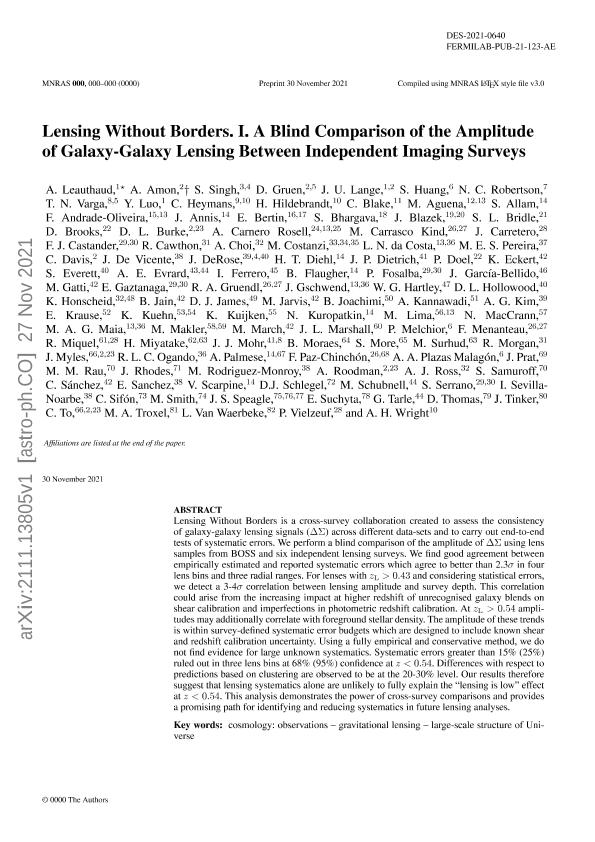Artículo
Lensing without borders - I. A blind comparison of the amplitude of galaxy-galaxy lensing between independent imaging surveys
Leauthaud, A.; Amon, A.; Singh, S.; Gruen, D.; Lange, J. U.; Huang, S.; Robertson, N. C.; Varga, T.N.; Luo, Y.; Heymans, C.; Hildebrandt, H.; Blake, C.; Aguena, M.; Allam, S.; Andrade Oliveira, F.; Annis, J.; Bertin, E.; Bhargava, S.; Blazek, J.; Bridle, S. L.; Brooks, D.; Burke, D. L.; Rosell, A. Carnero; Kind, M. Carrasco; Carretero, J.; Makler, Martín ; Troxel, M. A.; Van Waerbeke, L.; Vielzeuf, P.; Wright, A. H.
; Troxel, M. A.; Van Waerbeke, L.; Vielzeuf, P.; Wright, A. H.
 ; Troxel, M. A.; Van Waerbeke, L.; Vielzeuf, P.; Wright, A. H.
; Troxel, M. A.; Van Waerbeke, L.; Vielzeuf, P.; Wright, A. H.
Fecha de publicación:
03/2022
Editorial:
Wiley Blackwell Publishing, Inc
Revista:
Monthly Notices of the Royal Astronomical Society
ISSN:
0035-8711
Idioma:
Inglés
Tipo de recurso:
Artículo publicado
Clasificación temática:
Resumen
Lensing without borders is a cross-survey collaboration created to assess the consistency of galaxy-galaxy lensing signals (Δς) across different data sets and to carry out end-to-end tests of systematic errors. We perform a blind comparison of the amplitude of Δς using lens samples from BOSS and six independent lensing surveys. We find good agreement between empirically estimated and reported systematic errors which agree to better than 2.3σ in four lens bins and three radial ranges. For lenses with zL > 0.43 and considering statistical errors, we detect a 3-4σ correlation between lensing amplitude and survey depth. This correlation could arise from the increasing impact at higher redshift of unrecognized galaxy blends on shear calibration and imperfections in photometric redshift calibration. At zL > 0.54, amplitudes may additionally correlate with foreground stellar density. The amplitude of these trends is within survey-defined systematic error budgets that are designed to include known shear and redshift calibration uncertainty. Using a fully empirical and conservative method, we do not find evidence for large unknown systematics. Systematic errors greater than 15 per cent (25 per cent) ruled out in three lens bins at 68 per cent (95 per cent) confidence at z < 0.54. Differences with respect to predictions based on clustering are observed to be at the 20-30 per cent level. Our results therefore suggest that lensing systematics alone are unlikely to fully explain the 'lensing is low' effect at z < 0.54. This analysis demonstrates the power of cross-survey comparisons and provides a promising path for identifying and reducing systematics in future lensing analyses.
Palabras clave:
COSMOLOGY: OBSERVATIONS
,
LARGE-SCALE STRUCTURE OF UNIVERSE
Archivos asociados
Licencia
Identificadores
Colecciones
Articulos (ICIFI)
Articulos de INSTITUTO DE CIENCIAS FISICAS
Articulos de INSTITUTO DE CIENCIAS FISICAS
Citación
Leauthaud, A.; Amon, A.; Singh, S.; Gruen, D.; Lange, J. U.; et al.; Lensing without borders - I. A blind comparison of the amplitude of galaxy-galaxy lensing between independent imaging surveys; Wiley Blackwell Publishing, Inc; Monthly Notices of the Royal Astronomical Society; 510; 4; 3-2022; 6150-6189
Compartir
Altmétricas



